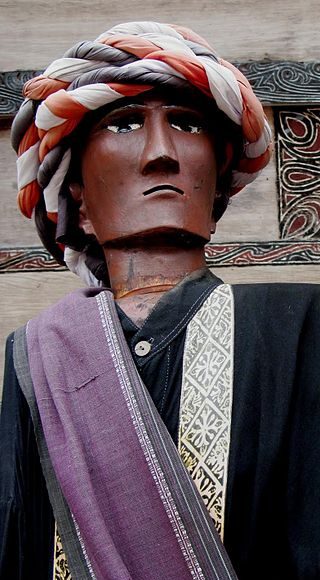Parmalim is an original spiritual teaching of the Batak natives in Indonesia. Even though they are a minority, parmalim are very strong in protecting and preserving the local wisdom of their ancestral heritage.
The recognition of the Batak ancestors of the power of Mulajadi Nabolon (Creator of the Universe) is not limited to a holy person. But also as a figure who is sovereign over nature, humans, and all aspects of life, including therein, sovereignty over arts and culture inherent in society.
If in the period before starting farming, the Batak ancestors held a manganjab ritual, praying for soil fertility, then after harvest, they held the Sipaha Lima tradition, to be grateful for the blessings of the harvest blessed by Mulajadi Nabolon.
In the center of the Parmalim settlement, in Huta Tinggi Village, Laguboti, Tobasa Regency, North Sumatra, the Sipaha Lima tradition is carried out every year. Malim is the religion of the Batak ancestors. Meanwhile, Parmalim means people who adhere to the Malim religion. This ancestral religion was oriented towards King Sisingamangaraja XII.
This religion was founded by Raja Mulia Naipospos. During the evangelism run by the missionary Ingwer Lodewyk Nommensen in Tanah Batak, Raja Mulia served at the HKBP Hutahaean Laguboti Church as a Huria Teacher. However, since leaving HKBP, Raja Mulia Naipospos has focused on establishing and raising the Malim religion. Currently the population of Parmalim is estimated at 6,000 people. They are scattered across the archipelago. Huta Tinggi is the center of Parmalim settlement.
For Parmalim, culture is not just a spiritual guide, but is like a torch for everyday life, whether in the midst of family, society, or nation and state. Local culture and wisdom is a bulwark from attacks by foreign cultures that are contrary to religious values and traditions.
In this ritual of Sipaha Lima, the Parmalim people carry a buffalo to the altar as a sacrifice. The buffalo was named Horbositikko, the horn of the pisoran. The ritual procession was led by Raja Ihutan Poltak Naipospos, as a substitute for the deceased King Ihutan Marnakkok Naipospos.
The ritual activities were followed by parents, teenagers, and even children. The ritual is accompanied by the music of Ogung Sabangunan (traditional Batak Toba musical instruments such as Tagading, Sarune, Ogung, Doal, Pangkeseki) and the people of Parmalim manortor (dancing) sahadaton accompanying the submission of offerings to God. Offerings such as chicken, goat, cooked fish, and kaffir lime in a cup previously prayed for in a bale parsantian (house of worship).
Parmalim devotees wear different clothes for men and women. Women must wear a kebaya, ulos, sarong, and have their hair dyed. Meanwhile, the men wear a white cloth tied over their head similar to a turban (ropes, in the Batak language) for those who are married, ulos, and sarong. Especially for the Parmalim leaders, they wore ulos covered with a white cloth. Meanwhile, the children wore sarongs and had their hair trimmed neatly. All people who attend the ritual procession are obliged not to wear footwear around the worship complex because the place of worship is believed to be sacred and holy.
At midday, Ogung Sabangunan was shy. The top Parmalim leaders came out in a line from inside the parsantian bale. Their hands while reciting prayers in order to send an offering made by Raja Ihutan to Mulajadi Nabolon. They pushed towards langgatan (the main stage in the yard).
In the center of the courtyard, a horbo (buffalo) is tied to a Borotan post, right next to a post. The buffalo is then slaughtered to be sacrificed. Parmalim believes that borotan is a symbol of how humans should treat the environment.
If humans cut down one tree, they must replant one tree in order to maintain the balance of nature. Being friendly with nature has become a teaching as well as a clear education in the Parmalim community.
The chairman of Punguan Parmalim Monang Naipospos said the Sipaha Lima ritual was the culmination of the matumona, which was an offering for the results of their business or work which was blessed by Mulajadi Nabolon for a year. This ritual usually lasts three full days from morning to night.
Before the top event, the Parmalim people first held a matumona event at their respective homes. Each family set aside their first crop to present to God. Because the Batak community is predominantly dependent on agriculture, the first harvest must be stored in the barn to be presented to Mulajadi Nabolon.
The first harvest results were then brought to be presented at the great ritual of Sipaha Lima. This ritual is usually held in the fifth month, according to the Batak calendar. Before preceding the Sipaha Lima ritual, Parmalim followers are obliged to offer a torop ugasan (support for three pikul of the harvest) per family head or more to the punguan head.
The torop area is similar to mutual assistance. Usually used for social purposes such as helping fellow Parmalim residents. For citizens with weak economies, they are exempted from this obligation.
If in the past the dominant society lived in the agrarian sector, now the Parmalim generation has penetrated various kinds of professions. With a similar principle, those who work outside the profession of farmers but receive a monthly wage, the salary is what is presented. The amount is adjusted to the value of the fields in the past agrarian times.
Monang said that the Parmalim people are adamant about maintaining their customs on the grounds that Batak culture has become a patron in everyday life. Seriousness in maintaining this culture and tradition in order to care for the nobility of the culture passed down from the ancestors. Come on, get interesting information from Indonesiar.com and visit Indonesia.































